 If you follow comics, you might have heard that Ernie Colón passed away last week after a battle with cancer. For me, it was sad but not unexpected news—I’d known about his condition since last year, when I’d started working with Ernie and his wife, Ruth Ashby, as the project manager on their graphic novel The Great American Documents, Volume II. (It’s a follow-up to their GAD, Volume I from 2014, both books packaged by Z File, Inc., the company owned and operated by our mutual friend, and my old editing boss, Howard Zimmerman.) The cancer had been in remission then, and Ernie had wasted no time in throwing himself into the work; he was one of those old-school artists whose one great hope always seemed to be that he’d be able to draw right up to the day they died.
If you follow comics, you might have heard that Ernie Colón passed away last week after a battle with cancer. For me, it was sad but not unexpected news—I’d known about his condition since last year, when I’d started working with Ernie and his wife, Ruth Ashby, as the project manager on their graphic novel The Great American Documents, Volume II. (It’s a follow-up to their GAD, Volume I from 2014, both books packaged by Z File, Inc., the company owned and operated by our mutual friend, and my old editing boss, Howard Zimmerman.) The cancer had been in remission then, and Ernie had wasted no time in throwing himself into the work; he was one of those old-school artists whose one great hope always seemed to be that he’d be able to draw right up to the day they died.
He came mighty close, God bless ’im. Not only had all of us completed the work on American Docs II at the start of July and the publisher had informed us the book was finally off to the printer, but Ernie and I (as his editor) were already knee-deep into his next project: what would have been his first children’s book—published by me, of all people. And since it was Ernie, it wouldn’t be a conventional kids’ book—the story he’d concocted had a quirky, somewhat adult sense of humor more reminiscent of Mad magazine; we used to joke about how kids would enjoy it while their parents freaked out. He wanted to finish it; I wanted him to finish it.
But when Ruth e-mailed me a couple of weeks ago to let me know that the cancer had returned in an even more aggressive form, and that Ernie was entering hospice-at-home care…well, it was just a matter of time, unfortunately.
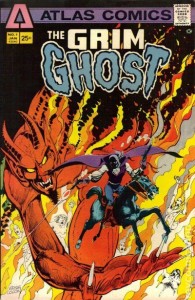 As a kid growing up, I’d probably first seen Ernie’s work in Harvey Comics’ Casper the Friendly Ghost and Richie Rich but didn’t know it, since Harvey never provided creator credits (years later, I was able to distinguish his art from others’ by the way he drew backgrounds). Probably the first mainstream comics work of his that I ever saw was in the 1970s, in Atlas Comics’ The Grim Ghost, a series (canceled with issue 3) about a 16th-century highwayman hung for his crimes and sent to hell, except the Devil returns him to Earth in the 20th century to collect souls.
As a kid growing up, I’d probably first seen Ernie’s work in Harvey Comics’ Casper the Friendly Ghost and Richie Rich but didn’t know it, since Harvey never provided creator credits (years later, I was able to distinguish his art from others’ by the way he drew backgrounds). Probably the first mainstream comics work of his that I ever saw was in the 1970s, in Atlas Comics’ The Grim Ghost, a series (canceled with issue 3) about a 16th-century highwayman hung for his crimes and sent to hell, except the Devil returns him to Earth in the 20th century to collect souls.
The fluid way he drew action scenes, the way he experimented with panel placements, the art style that was somewhere between straight and cartoony—all of it grabbed my attention. It wasn’t Jack Kirby or John Buscema or John Romita Sr., but damn if there wasn’t just something about it I found really appealing—so much so that as the years passed I made it a habit to buy pretty much any comic he drew: Tigerman, Airboy, Magnus Robot Fighter, Battlestar Galactica, Cosmic Boy, Star Wars: Droids (he did the two-issue adaptation of Episode IV), John Carter: Warlord of Mars, Beetlejuice, The 9/11 Report, even the reboots of Casper. Okay, not New Kids on the Block—I did say “pretty much any comic,” after all.
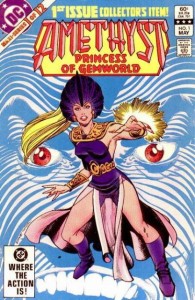 But it was in DC Comics’ young adult fantasy maxiseries Amethyst, Princess of Gemworld that I—and a lot of comic fans—got to see what Ernie could really do as an artist. Written by Dan Mishkin and Gary Cohn and published in the 1980s, it was Harry Potter before there was a Harry Potter, the story of a teenaged girl named Amy who discovers she’s really Princess Amethyst of a magical realm called Gemworld; when she crosses between the realms she becomes an adult but still with a teen’s mind. It’s one of the best works of Ernie’s career, but because it was a “girls’ comic,” because it was a fantasy, because it was YA it never got the attention it deserved. SyFy Wire just this year called it an “underrated classic.” If you’ve never read Amethyst, do yourself a favor and check it out.
But it was in DC Comics’ young adult fantasy maxiseries Amethyst, Princess of Gemworld that I—and a lot of comic fans—got to see what Ernie could really do as an artist. Written by Dan Mishkin and Gary Cohn and published in the 1980s, it was Harry Potter before there was a Harry Potter, the story of a teenaged girl named Amy who discovers she’s really Princess Amethyst of a magical realm called Gemworld; when she crosses between the realms she becomes an adult but still with a teen’s mind. It’s one of the best works of Ernie’s career, but because it was a “girls’ comic,” because it was a fantasy, because it was YA it never got the attention it deserved. SyFy Wire just this year called it an “underrated classic.” If you’ve never read Amethyst, do yourself a favor and check it out.
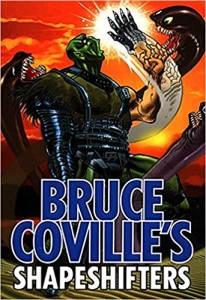 And then in the mid-1990s I got hired as an assistant editor by a book-packaging company called Byron Preiss Visual Publications (I’ve told stories in the past about working there). One of my earliest assignments was to take over a four-book anthology series that needed an editor—and an artist. It was either Byron or Howard who suggested Ernie, and when I called him he was as charming and funny and laid-back as the stories I’d heard about him said he’d be. He provided all the covers and pencils for the interior spot illustrations, but he hated the inking on the illos (not by him but another artist) so much that he insisted I destroy the art rather than return it to him. Absolutely demanded I wipe their existence from the face of the Earth.
And then in the mid-1990s I got hired as an assistant editor by a book-packaging company called Byron Preiss Visual Publications (I’ve told stories in the past about working there). One of my earliest assignments was to take over a four-book anthology series that needed an editor—and an artist. It was either Byron or Howard who suggested Ernie, and when I called him he was as charming and funny and laid-back as the stories I’d heard about him said he’d be. He provided all the covers and pencils for the interior spot illustrations, but he hated the inking on the illos (not by him but another artist) so much that he insisted I destroy the art rather than return it to him. Absolutely demanded I wipe their existence from the face of the Earth.
They’re in my personal art collection. Hey, he said he didn’t want them…
At some point I started to call him “Maestro” whenever we began a phone conversation. I don’t know why, or where it came from, but I just did it, and I kept calling him Maestro right up to our last talk this past July. A friend of mine thinks it was my way of showing respect to someone older than me (Ernie celebrated his 88th birthday on July 10), but even more because I admired and respected him. Sounds right. He, in turn, called me Esteban.
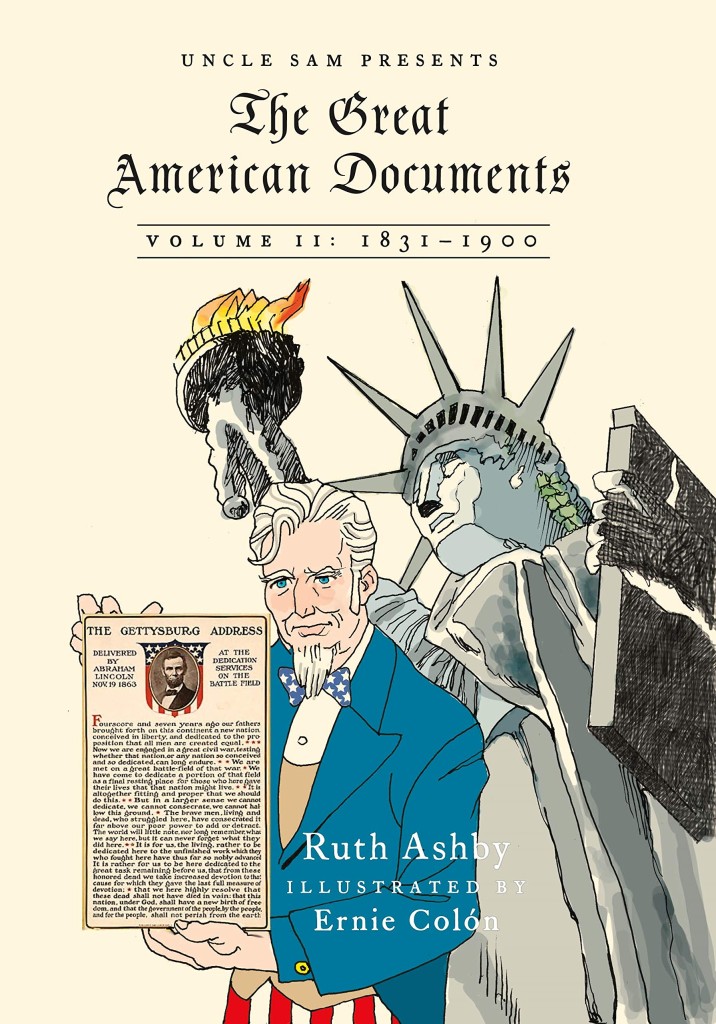 I had the pleasure of working with Ernie a number of times since then: I got him to contribute an illustration for a Marvel-related anthology I edited in 1998, The Ultimate Hulk. He drew a history of succubi for my graphic novel Lorelei: Sects and the City. He drew the Sholly Fisch–scripted “After Hours” in The Saga of Pandora Zwieback Annual #1. And of course there’s the upcoming Great American Documents, Volume II.
I had the pleasure of working with Ernie a number of times since then: I got him to contribute an illustration for a Marvel-related anthology I edited in 1998, The Ultimate Hulk. He drew a history of succubi for my graphic novel Lorelei: Sects and the City. He drew the Sholly Fisch–scripted “After Hours” in The Saga of Pandora Zwieback Annual #1. And of course there’s the upcoming Great American Documents, Volume II.
And when I went through a health scare in 2018 (long story), there was Ernie, calling me just about every day. The guy battling cancer, checking to see how I was doing.
Ask anyone who knew him and they’ll tell you Ernie Colón was a fighter, and he was, right up to his last day. He went fifteen rounds with that motherfucker cancer, but in the end it wore him down.
I just wish we’d been able to talk one last time before he left the ring.
Rest in Peace, Maestro. You’ve earned it.
Steve


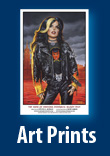




Pingback: Ernie Colón: The Passing of a Comic Book Legend | The Saga of Pandora Zwieback